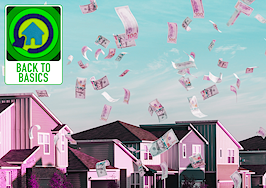Digital farming is a low to no-cost real estate farming strategy that will add value to the people on your email list and generate more listings as a result. Here’s a proven method I’ve used in my own business to provide the kind of value that leads to relationships and transactions.
What is digital farming?
Digital farming begins with an email list of owners in a particular neighborhood that allows us to reach out to those people and provide value consistently. Digital farming doesn’t replace things like mailers, phone calls and circle prospecting. But it is a low-cost strategy that makes good use of your time and keeps homeowners updated about activity in their neighborhood.
Once we build an email list, digital farming works precisely the same way mailers do: We’ll send the same kind of information we send in mailers but in a video email format.
Doing this gives us the ability to add value that will position us as the go-to expert on real estate in the neighborhood.
1. Build an email list
Email addresses have become relatively accessible, so they aren’t too hard to find with a bit of research, and the best place to begin is in our own neighborhoods. Your HOA or your neighborhood likely has a contact list of owners for owners that will include addresses, email addresses and other information. Begin your database using that information.
If your neighborhood doesn’t have one, start with a previous client in an area you would like to begin farming who might have some of that information, and ask the question this way to eliminate any worries about sharing the list.
I would love to add value to your neighbors, and I can assure you I’ll never spam anyone. Do you happen to know if your HOA has a list of the other homeowners in your neighborhood? I simply want to let them know about the activity in the neighborhood. If you happen to have a copy of it, I’d love to utilize it to set up monthly neighborhood sales updates like the ones I provide you.
Beyond that option, services like TruthFinder or Fiverr are options for gathering emails. TruthFinder is an app that provides background checks and contact information on homeowners. The process of building an email address through TruthFinder takes time, but once it’s in place, you are all set. Although not 100 percent accurate, this has been the tool we’ve used to build the most accurate lists we can find.
Fiverr.com is an option where you can hire people to build an email list from a list of owners’ names that you’ll provide. Note that these addresses are about 60 percent accurate, but in a large neighborhood of 500 owners, that’s still a significant way to begin your list.
Other options for gathering email addresses include PropStream and for primary residences, Cole Realty Resource.
2. Format the email
Once we’ve built our email list, the next step is to provide information in a way that catches the owners’ attention and keeps it by providing valuable content they want to consume.
This process starts with personalizing the subject line of your email to the neighborhood you’re addressing. For example, Live Oak Subdivision May Sales Update. Use a very specific title that indicates that this is current information about the sales activity in this particular neighborhood because it will significantly improve your cold email open rates.
In the top portion of the email, use a photo of yourself with a play button on it because the play button is the most irresistible thing on the internet right now.
You can create this graphic on a site such as Canva using the following steps:
- Take a photo of yourself in front of a recognizable part of the neighborhood you’re farming.
- Search for a YouTube play button on Google Images.
- Add that play button graphic right to the middle of your neighborhood photo.
- Directly above the play button, add text that matches your subject line directly on your photo.
- Add a hyperlink to the video update you’ve recorded (instructions are below).
3. Create video
The video we send to the email list will be a screen recording of updated information about the activity in the neighborhood, and we can record it using Zoom, BombBomb or any other video tool. If you’re apprehensive about appearing on video, you can remove your window from the recording, and record the screen and your voice, but take note that the audience will get to know you better if they can see your face.
Before you begin recording, pull up the MLS sheets that show active, pending, and sold properties in the neighborhood. Then, once you’re recording, you can show the list of active homes and use the cursor to highlight information on the page.
Do the same with the pending page, explaining that these homes went under contract within the past 90 days. Then, wrap up the MLS portion by showing the homes that have sold. Next, explain to the audience what this information means.
From the current and past activity, you can see that prices are increasing, so if you’re curious to know what your own home might sell for, I’d love to give you an updated no-obligation valuation of your property. Simply email me back, and I will be glad to provide your home’s value.
Then, let the audience know how you can keep them updated about the activity in their area.
I also wanted to let you know that we have an automated system that sends updates each time a home in Live Oak Subdivision comes on the market, goes under contract or sells. If you’re interested in receiving these updates, email me, and I’ll make sure you receive these automated updates.
Your local MLS should have an automated system that will email the contact details when an activity in their neighborhood happens, or you can use a contact management program. We use Boomtown.
Once you’ve finished the video, you need to host it somewhere like YouTube, Vimeo or BombBomb. Upload the video to your video platform, and then create a link to that video. Finally, add that link to the photo you made for the top of the email so that when the audience clicks on the image with the play button, it’ll direct them to the video you’ve created for them.
4. Put together email text
Although video is a great way to connect with people, not everyone watches video, so the email text will provide the same information that we included in the video. As you build this email, though, understand that people are scanners, so they’re going to look for the critical information in your content. Bold headings will help you make your content easily scannable.
Use a bold heading directly below the video using the subject line of the email: Live Oak Subdivision March Sales Update.
Below that, build one paragraph that gives an overview of activity and updated information about the neighborhood like this:
Live Oak Subdivision continues to show strength and increasing home values. This past month, we had three houses come on the market, two that went pending and three that sold, listed below.
Then, if you have a specific buyer who wants to live in that neighborhood, you can invite the neighbors to help you identify any potential sellers.
I have a great family who loves your neighborhood and is looking to buy in Live Oak Subdivision within the next 90 days, so if you know of anyone with a three-bedroom house who might consider selling, please let me know.
Actives
The next section will begin with the bold heading Active Listings For Sale in Live Oak Subdivision, and we’ll include a list of all the active properties. The way I structured the information was similar to the following.
123 Live Oak Avenue is a three-bedroom, two-bath home priced at $400,000 (or whatever the list price is), and it has been on the market for 25 days. 147 Live Oak Avenue is a four-bedroom, three-bath, priced at $500,000, and it has been on the market for 12 days.
Pendings
The next bold heading will be Pending Contracts in Live Oak Subdivision, and we’ll include everything that is scheduled to close, with a description of the home and the date it’s scheduled to close.
Solds
The final bold heading will be Sold Properties in Live Oak Subdivision, and we’ll include information about the home, a description of the property, the date it closed, the number of square feet, and the final price-per-square foot it sold for.
5. Craft a soft call-to-action
Wrap the email up this way with the information I mentioned briefly above:
The market is moving fast, so if you’re curious about the value of your own home, don’t hesitate to reach out, and I’ll provide you with a free, no-obligation updated valuation analysis of your home.
Also, we have an automated system that sends updates each time a home in Live Oak Subdivision goes under contract or sells. If you’re interested in receiving these updates, email me, and I’ll schedule you to begin receiving that information immediately as activity happens.
Note that we aren’t asking if they want to list their homes; we’re simply adding value to the people in the neighborhood. If they are considering selling, they will respond.
Expanding your efforts
Repetition builds your reputation as the expert in this area. Every month, we’ll send an email in the same format, with updated numbers and information. I’ve seen this result in requests from homeowners for updated valuations on their properties. They’ll ask things like when to sell, whether to update a kitchen and other questions that allow us to operate as the resource for the owners in this area.
Then, when you get your first listing, send a just-listed email to the same group, and continue to connect with them each time something happens in the community.
The results
Because we aren’t asking them to do anything, I’ve never had anyone complain about this kind of outreach or suggest that I was providing too much information. Instead, because we’re connecting with our email list once a month, we’re building a reputation as the expert in the neighborhood.
I had about a 78 percent open rate with these emails in my personal experience — compared to an industry standard of about 17 percent. I know this works because I’ve used it in my business, and it will work in yours as well.
Once we build an email list and create the format for the content, digital farming costs us almost nothing except our time, and it will help establish us as the expert in the neighborhood we’re seeking to farm.
Jimmy Burgess is the Chief Growth Officer for Berkshire Hathaway HomeServices Beach Properties of Florida in Northwest Florida. Connect with him on Facebook or Instagram.













